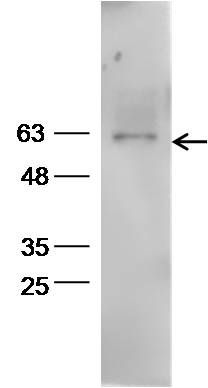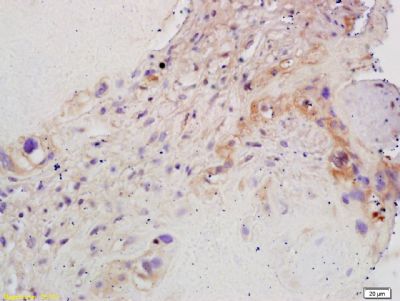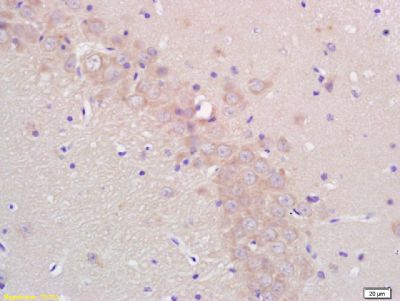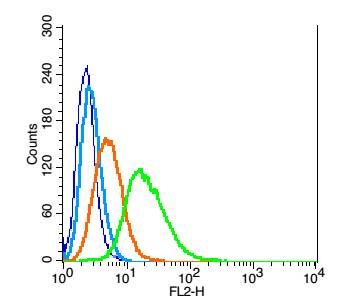细胞色素P450 19抗体
产品名称: 细胞色素P450 19抗体
英文名称: Aromatase
产品编号: 1292
产品价格: null
产品产地: 上海
品牌商标: 雅吉
更新时间: null
使用范围: WB ELISA IHC-P IHC-F Flow-Cyt ICC IF
上海雅吉生物科技有限公司
- 联系人 :
- 地址 : 上海市闵行区元江路5500号第1幢5658室
- 邮编 :
- 所在区域 : 上海
- 电话 : 158****3937 点击查看
- 传真 : 点击查看
- 邮箱 : yajikit@163.com
| 中文名称 | 细胞色素P450 19抗体 |
| 别 名 | Cytochrome p450 19A1; Estrogen synthetase; ARO 1; ARO; ARO1; CPV; CYPXIX; Cytochrome P450 family 19 subfamily A polypeptide 1; MGC104309; P 450AROM; P450AROM; CP19A_HUMAN; Cytochrome P-450AROM; CPV1; CYAR; CYP19; Cyp19a1; Cytochrome P450, family 19, subfamily A, polypeptide 1; Cytochrome P450, subfamily XIX (aromatization of androgens); Flavoprotein linked monooxygenase; Microsomal monooxygenase; OTTHUMP00000162543; OTTHUMP00000198350; P 450AROM. |
| 研究领域 | 肿瘤 细胞生物 |
| 抗体来源 | Rabbit |
| 克隆类型 | Polyclonal |
| 交叉反应 | Human, Rat, (predicted: Mouse, Dog, Pig, Cow, Horse, Rabbit, Sheep, ) |
| 产品应用 | WB=1:500-2000 ELISA=1:500-1000 IHC-P=1:100-500 IHC-F=1:100-500 Flow-Cyt=1μg/Test ICC=1:100-500 IF=1:100-500 (石蜡切片需做抗原修复) not yet tested in other applications. optimal dilutions/concentrations should be determined by the end user. |
| 分 子 量 | 58kDa |
| 细胞定位 | 细胞膜 |
| 性 状 | Liquid |
| 浓 度 | 1mg/ml |
| 免 疫 原 | KLH conjugated synthetic peptide derived from human CYP19:41-140/503 |
| 亚 型 | IgG |
| 纯化方法 | affinity purified by Protein A |
| 储 存 液 | 0.01M TBS(pH7.4) with 1% BSA, 0.03% Proclin300 and 50% Glycerol. |
| 保存条件 | Shipped at 4℃. Store at -20 °C for one year. Avoid repeated freeze/thaw cycles. |
| PubMed | PubMed |
| 产品介绍 | This gene encodes a member of the cytochrome P450 superfamily of enzymes. The cytochrome P450 proteins are monooxygenases which catalyze many reactions involved in drug metabolism and synthesis of cholesterol, steroids and other lipids. This protein localizes to the endoplasmic reticulum and catalyzes the last steps of estrogen biosynthesis, three successive hydroxylations of the A ring of androgens. Mutations in this gene can result in either increased or decreased aromatase activity; the associated phenotypes suggest that estrogen functions both as a sex steroid hormone and in growth or differentiation. The gene expresses two transcript variants. Belongs to the cytochrome P450 family. Function: Catalyzes the formation of aromatic C18 estrogens from C19 androgens. Subcellular Location: Membrane; Peripheral membrane protein. Tissue Specificity: Brain, placenta and gonads. DISEASE: Defects in CYP19A1 are a cause of aromatase excess syndrome (AEXS) [MIM:139300]; also known as familial gynecomastia. AEXS is characterized by an estrogen excess due to an increased aromatase activity. Defects in CYP19A1 are the cause of aromatase deficiency (AROD) [MIM:613546]. AROD is a rare disease in which fetal androgens are not converted into estrogens due to placental aromatase deficiency. Thus, pregnant women exhibit a hirsutism, which spontaneously resolves after post-partum. At birth, female babies present with pseudohermaphroditism due to virilization of extern genital organs. In adult females, manifestations include delay of puberty, breast hypoplasia and primary amenorrhoea with multicystic ovaries. Similarity: Belongs to the cytochrome P450 family. SWISS: P11511 Gene ID: 1588 Database links: Entrez Gene: 1588 Human Entrez Gene: 13075 Mouse Entrez Gene: 25147 Rat Omim: 107910 Human SwissProt: P11511 Human SwissProt: P28649 Mouse Important Note: This product as supplied is intended for research use only, not for use in human, therapeutic or diagnostic applications. 芳香化酶基因(CYP19)编码的芳香化酶是催化雄激素向雌激素转化的关键酶,CYP19的变异可使芳香化酶活性改变,导致雌激素水平的改变,从而使乳腺癌易感性发生改变,也可能影响到乳腺癌内分泌治疗的敏感性。 目前关于CYP19基因多态性与乳腺癌之间的关系仍存在争论,尚需深入研究以明确芳香化酶的基因多态性在乳腺癌发生中的作用,以及该基因多态性对芳香化酶功能的影响。 |
| 产品图片 |  Sample:HepG2 Cell Lysate at 40 ug Sample:HepG2 Cell Lysate at 40 ugPrimary: Anti- CYP19 (bs-1292R) at 1/300 dilution Secondary: IRDye800CW Goat Anti-Rabbit IgG at 1/20000 dilution Predicted band size: 58 kD Observed band size: 60 kD  Tissue/cell: human placenta tissue; 4% Paraformaldehyde-fixed and paraffin-embedded; Tissue/cell: human placenta tissue; 4% Paraformaldehyde-fixed and paraffin-embedded;Antigen retrieval: citrate buffer ( 0.01M, pH 6.0 ), Boiling bathing for 15min; Block endogenous peroxidase by 3% Hydrogen peroxide for 30min; Blocking buffer (normal goat serum,C-0005) at 37℃ for 20 min; Incubation: Anti-CYP19/CYP19A1 Polyclonal Antibody, Unconjugated(bs-1292R) 1:200, overnight at 4°C, followed by conjugation to the secondary antibody(SP-0023) and DAB(C-0010) staining  Tissue/cell: rat brain tissue; 4% Paraformaldehyde-fixed and paraffin-embedded; Tissue/cell: rat brain tissue; 4% Paraformaldehyde-fixed and paraffin-embedded;Antigen retrieval: citrate buffer ( 0.01M, pH 6.0 ), Boiling bathing for 15min; Block endogenous peroxidase by 3% Hydrogen peroxide for 30min; Blocking buffer (normal goat serum,C-0005) at 37℃ for 20 min; Incubation: Anti-CYP19/CYP19A1 Polyclonal Antibody, Unconjugated(bs-1292R) 1:200, overnight at 4°C, followed by conjugation to the secondary antibody(SP-0023) and DAB(C-0010) staining  Blank control: RSC96 (blue). Blank control: RSC96 (blue).Primary Antibody:Rabbit Anti- CYP19 antibody(bs-1292R), Dilution: 1μg in 100 μL 1X PBS containing 0.5% BSA; Isotype Control Antibody: Rabbit IgG(orange) ,used under the same conditions ); Secondary Antibody: Goat anti-rabbit IgG-PE(white blue), Dilution: 1:200 in 1 X PBS containing 0.5% BSA. Protocol The cells were fixed with 2% paraformaldehyde (10 min). Primary antibody (bs-1292R, 1μg /1x10^6 cells) were incubated for 30 min on the ice, followed by 1 X PBS containing 0.5% BSA + 1 0% goat serum (15 min) to block non-specific protein-protein interactions. Then the Goat Anti-rabbit IgG/PE antibody was added into the blocking buffer mentioned above to react with the primary antibody at 1/200 dilution for 30 min on ice. Acquisition of 20,000 events was performed. |
